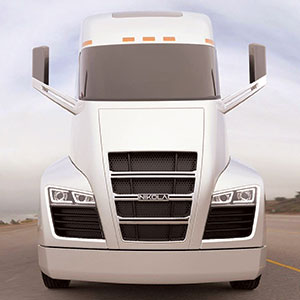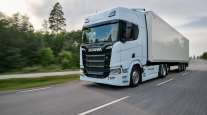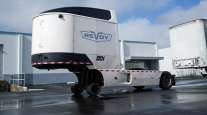Electric Trucks Are Promising, but Industry Must Understand Full Energy Needs

Editor's note: An earlier version of this article incorrectly stated the 2017 percentage of solar power and wind power among all power sources in the U.S.
It’s time to start discussing electric trucks in light of the reality that they only handle part of the energy required for propulsion, leaving important aspects of energy production to external power sources.
An electric truck on display at a trade show recently touted that the vehicle gets 30 mpg equivalent in terms of the energy needed to drive it, but did not add that the figure includes only the energy that’s already in the batteries as it flows to the wheels.
When it comes to energy, a diesel engine handles the entire energy production process. An electric truck’s batteries and motors are almost like a diesel drivetrain without the engine.

Baxter
The industry needs to be open about the fact that fossil fuels used in unseen engines located in power stations will generate much of the electricity that will actually power those electric vehicles and qualify its statements about “zero-emission” electric trucks. They may be zero emission locally, but not necessarily in the region where they run.
And another problem is not mentioned: The power grid is vulnerable. It could run short of power — resulting in rolling blackouts, or brownouts — where voltage drops and batteries would charge far more slowly, or not at all. Will the power grid be able to handle much of the energy used in transportation?
A positive note, however, is that the increasing potential for solar and wind power to supplement traditional sources of energy is encouraging in terms of the emissions produced by electric vehicles.
Kellen Schefter, senior manager for sustainable technology at Edison Electric Institute, noted the historic growth in “green” power: In 2007, wind generation was at about 1% of all U.S. power generated, and solar less than that.
By 2017, solar was more than 2% and wind was at 6%. “We’ll see both increase over time,” Schefter said.
But there’s a downside here, too, as described in an article in the June issue of Mechanical Engineering. Solar panel output drops at about 5 p.m. This produces something called “the duck curve” of demand and supply that requires rapid ramp-up of other power sources, the publication reported. Because the turbines involved in producing power from fossil fuels can tolerate only a finite rate of load change, large banks of batteries and inverters will be needed to make up the difference.

The electric Nikola One. (Nikola Motor Co.)
Tom Dollmeyer, executive engineer at the electrified power business at engine maker Cummins, said that electric vehicles such as the Cummins Aeos concept truck have an advantage in drayage-type operations because they recover energy versus using the service brakes. Instead of applying the service brakes, they turn the motors into generators and put braking energy back into the batteries.
The reality of electric trucks is promising. The high mileage quoted for the electric truck on display at the trade show exemplifies how advantageous electric drive is. Electric drivetrains are more efficient at moving power to the wheels than a mechanical drivetrain, and their energy recovery capability also helps.
Several industry experts also provided an encouraging perspective on grid capacity.
“There is enough energy production capacity in the U.S. to support significant growth in electric vehicle use,” said Rick Mihelic, director of Future Technologies Studies for the North American Council for Freight Efficiency. “EV growth will not happen overnight and the infrastructure will adapt to demand.”
Dan Bowermaster, a program manager with the Electric Power Research Institute, said that only about 3.5% of today’s energy consumption would equate to the energy needed for 65% of today’s ton-miles of trucking, and that amount of grid capacity is already available.
“It is more advantageous for generating plants to run at a more constant output, so if demand increases at night due to electric vehicle charging, that will drive greater efficiencies, since nighttime demand is less than daytime demand,” he added.
Edison Electric Institute’s Schefter said that there will be significant pricing incentives built into electric rates for overnight charging for that reason.
Finally, there also is good news in terms of emissions. Dollmeyer provided data showing that an electric car in 2016 produced the CO2 equivalent of a gasoline car getting 46 mpg, an improving number. That’s because the percentage of electric power coming from coal has dropped from 43% in 2009 to about 30% by 2016 because of the substitution of natural gas. Gas has half the carbon content of coal and can generate power more efficiently.
Despite the encouraging perspectives and some of the good news, those touting electric trucks should start adding the relevant energy context to their marketing, if only to help potential buyers feel confident that the power they need will be there.
John Baxter has covered the trucking industry for nearly 30 years. He is a member of SAE and the American Society of Mechanical Engineers.




